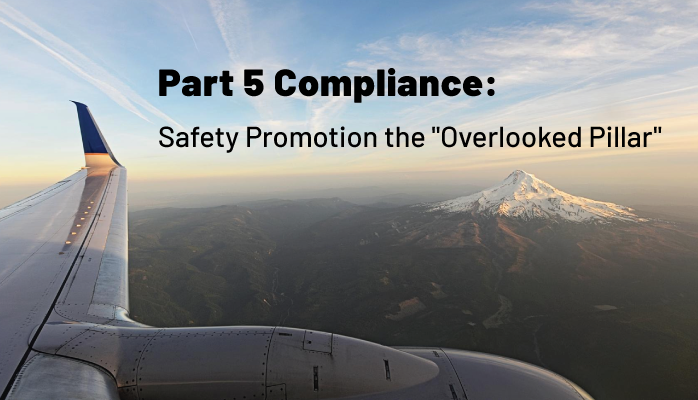Safety Promotion as an Aviation SMS Pillar

Since November 2006, ICAO mandated that aviation service providers implement formal aviation safety management systems (SMS). The objective of the aviation SMS is to:
- Proactively manage safety,
- Identify potential hazards,
- Determine operational risk, and
- Implement risk control measures;
- Continuously monitor system for hazards; and
- Demonstrate continuous improvement of the SMS.
Properly implemented aviation SMS follows the ICAO standard. The SMS structure is based on four components (or pillars) and twelve elements. The four components are:
- Safety Policy;
- Safety Risk Management;
- Safety Assurance; and
- Safety Promotion.
Related Articles on Four Pillars in Aviation SMS
- What Are the 4 Pillars of SMS?
- History of Aviation SMS and Four Pillars - With Free Tools
- Who Started Four Pillars of Safety Management in Aviation?
FAA Importance Not Stressed on Safety Promotion
A few comments regarding the Safety Promotion requirements need to be discussed before we jump in.
The Safety Risk Management (SRM) and Safety Assurance (SA) pillars of SMS receive by far the most attention by both:
- aviation service providers;
- and aviation oversight agencies.
Lagging far behind them is Safety Policy.
Just consider, the Federal Aviation Administration gives Safety Promotion in its Advisory Circular and Part 5 Requirements far less coverage than the other pillars:
- Safety Policy receives 6 pages of coverage:
- Safety Risk Management receives 12 pages of coverage;
- Safety Assurance receives 15 pages of coverage; and
- Safety Promotion receives 3 pages of coverage.
What Are Main Elements of Safety Promotion Pillar?

In the shadow of SRM and SA, it’s easy to overlook just how important Safety Promotion is. This pillar accounts for:
- Safety communication;
- Safety awareness;
- Safety training;
- Safety competency; and
- Safety culture.
In short, Safety Promotion covers all of the mission-critical mechanisms required to successfully fuel SRM and SA performance. You could even make the argument that Safety Promotion will make the most important difference between safety adequacy and inadequacy.
Safety promotion will always remain a key factor in safety performance!
Poor demonstrations of Safety Promotions will completely and totally cripple a safety management system. No other pillar can boast such a claim to such a degree. So it should be stressed that while Safety Promotion receives only 8% of the coverage in FAA’s Part 5 analysis, providers cannot underestimate how important this element is.
Related Aviation SMS Safety Promotion Articles
- Why Safety Promotion Requires More Focus in Aviation SMS
- Safety Chart: Stay on Top of Aviation Safety Promotion With SMS Newsletters
- Why Safety Promotion Component Is the Overlooked Pillar in Aviation SMS
Safety Promotion and Aviation Safety Training
Part 5.91 indicates that one of the primary roles of the Safety Promotion element of SMS is to, “provide training to each individual identified in [the Safety Policy pillar]…” The Advisory Circular then goes on to partition aviation safety training into:
- “Initial training... to understand and perform duties” (AC, 3-6.b.6); and
- “Recurrent training... to reinforce these skills.” (AC, 3-6.b.6)
It’s extremely important to point out that the FAA indicates that recurrent training builds on initial training, i.e., “reinforce [the skills learned during initial training].” The implication here is the initial training is extremely important, as its goal is to set down the foundational skills an employee needs to know to perform their duties.
Other important factors about safety training are:
- Different employees will require different amounts of training based on their role or position within the SMS;
- There are many forms of safety training, such as formal training, newsletters, safety articles, etc.;
- Safety training effectiveness should be monitored; and
- Aviation safety training will only work if it’s good training.
All roles that require SMS training need to be documented in the Safety Policy, as Part 5 indicates.
What Is Safety Competency in Safety Promotion

Part 5 says that the goal of safety training is to “maintain the competencies necessary to perform…duties relevant to the operation and performance of the SMS” (5.91).
Competency is a vague word, which fortunately is explained a bit further in the AC. Does competency mean “meet the requirements”? How does one test competency? As defined by the FAA, competency is made up of observable and measurable:
- Skills;
- Knowledge;
- Abilities;
- Behaviors; and
- Actions employees exhibit.
The keywords here are observable and measurable. The implication is that you are defining what competency means with your goals and objectives, and then tracking those competencies with:
- Key Performance Indicators (KPIs);
- Leading indicators;
- End-of-training assessment testing;
- Evaluations; and
- Other forms of safety performance monitoring.
Reviewing safety training is necessary for continuous improvement, which is a part of the FAA’s Safety Assurance process.
Related Aviation SMS Training Articles
- Training Management in Aviation SMS
- Learn Why Initial SMS Training Is So Crucial for Aviation SMS Success
- Tips to Automate Aviation SMS Training for Initial/Recurrent Requirements (Free Resources)
Safety Promotion Is Safety Communication
The second and final portion of the FAA’s Safety Promotion element is safety communication. The FAA requires that “The certificate holder must develop and maintain means for communicating safety information…” (5.93). This safety communication needs to:
- Ensure that employees are aware of resources and guidelines relevant to their positions (5.93)(a);
- Convey hazard information to employees (5.93)(b);
- Convey what safety actions are being taken (5.93)(c); and
- Convey new/updated procedures to the SMS program (5.93)(b).
The keyword here is “maintain means for communicating...” What are these means, or what could they be? Simply put, your safety management system needs some kind of content-delivery system that can be monitored and documented, such as:
- Safety meetings;
- Posters;
- Paper content distribution, such as newsletters, fliers, etc.;
- Email;
- Messaging system; and
- YouTube video channel (for distributing video description of safety information).
The most effective communication technique is to deliver relevant content to relevant employees. If you drown every employee with every piece of new safety information, they will become information-blind, and may potentially miss seeing important information. Keeping information relevant will help keep employees paying attention.
Final Thought: Indications of Safety Promotion Compliance
Fortunately, as the Safety Promotion pillar is such a small part of Part 5 requirements, managing compliance is fairly easy:
- You have established (documented) methods of communicating;
- You are tracking and documenting the training status of each employee; and
- You are tracking the connection between safety training and safety performance.
Beyond compliance, organizations that invest resources into Safety Promotion should expect to see significant, and beneficial, returns on safety performance.
For an eBook on further information about FAA Part 5 compliance, see the link below:
Last updated in April 2024.






